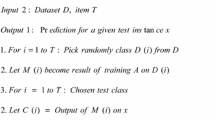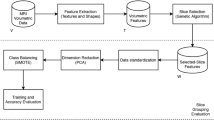Abstract
The recent studies in Morphometric Magnetic Resonance Imaging (MRI) have investigated the abnormalities in the brain volume that have been associated diagnosing of the Alzheimer’s Disease (AD) by making use of the Voxel-Based Morphometry (VBM). The system permits the evaluation of the volumes of grey matter in subjects such as the AD or the conditions related to it and are compared in an automated manner with the healthy controls in the entire brain. The article also reviews the findings of the VBM that are related to various stages of the AD and also its prodrome known as the Mild Cognitive Impairment (MCI). For this work, the Ada Boost classifier has been proposed to be a good selector of feature that brings down the classification error’s upper bound. A Principal Component Analysis (PCA) had been employed for the dimensionality reduction and for improving efficiency. The PCA is a powerful, as well as a reliable, tool in data analysis. Calculating fitness scores will be an independent process. For this reason, the Genetic Algorithm (GA) along with a greedy search may be computed easily along with some high-performance systems of computing. The primary goal of this work was to identify better collections or permutations of the classifiers that are weak to build stronger ones. The results of the experiment prove that the GAs is one more alternative technique used for boosting the permutation of weak classifiers identified in Ada Boost which can produce some better solutions compared to the classical Ada Boost.





Similar content being viewed by others
References
Zhang, Y., Dong, Z., Phillips, P., Wang, S., Ji, G., Yang, J., and Yuan, T. F., Detection of subjects and brain regions related to Alzheimer's disease using 3D MRI scans based on eigenbrain and machine learning. Frontiers in Computational Neuroscience 9:66, 2015.
Zhang, Y., Wang, S., and Dong, Z., Classification of Alzheimer disease based on structural magnetic resonance imaging by kernel support vector machine decision tree. Progress In Electromagnetics Research 144:171–184, 2014.
Karas, G. B., Burton, E. J., Rombouts, S. A. R. B., Van Schijndel, R. A., O’Brien, J., Scheltens, P. H. et al., A comprehensive study of gray matter loss in patients with Alzheimer’s disease using optimized voxel-based morphometry. Neuroimage 18(4):895–907, 2003.
Hirata, Y., Matsuda, H., Nemoto, K., Ohnishi, T., Hirao, K., Yamashita, F. et al., Voxel-based morphometry to discriminate early Alzheimer's disease from controls. Neuroscience letters 382(3):269–274, 2005.
Gorji, H. T., and Haddadnia, J., A novel method for early diagnosis of Alzheimer’s disease based on pseudo Zernike moment from structural MRI. Neuroscience 305:361–371, 2015.
Mahanand, B. S., Babu, G. S., Suresh, S., & Sundararajan, N. (2015). Identification of imaging biomarkers responsible for Alzheimer's disease using a McRBFN classifier. In Cognitive Computing and Information Processing (CCIP), 2015 International Conference on (pp. 1–4). IEEE.
Chyzhyk, D., Savio, A., and Graña, M., Evolutionary ELM wrapper feature selection for Alzheimer's disease CAD on anatomical brain MRI. Neurocomputing 128:73–80, 2014.
Beheshti, I., Demirel, H., Matsuda, H., and Initiative, A.'s. D. N., Classification of Alzheimer's disease and prediction of mild cognitive impairment-to-Alzheimer's conversion from structural magnetic resource imaging using feature ranking and a genetic algorithm. Computers in biology and medicine 83:109–119, 2017.
Zhang, Y., Wang, S., Sui, Y., Yang, M., Liu, B., Cheng, H., ... &Gorriz, J. M. (2017). Multivariate Approach for Alzheimer’s Disease Detection Using Stationary Wavelet Entropy and Predator-Prey Particle Swarm Optimization. Journal of Alzheimer's Disease, (Preprint), 1–15.
Popuri, K., Balachandar, R., Alpert, K., Lu, D., Bhalla, M., Mackenzie, I. R. et al., Development and validation of a novel dementia of Alzheimer's type (DAT) score based on metabolism FDG-PET imaging. NeuroImage: Clinical 18:802–813, 2018.
Nandi, D., Ashour, A. S., Samanta, S., Chakraborty, S., Salem, M. A., and Dey, N., Principal component analysis in medical image processing: a study. International Journal of Image Mining 1(1):65–86, 2015.
Mikki, M. (2013). Brain Tumor Detection Based On Curvelet and Artificial Neural Network (Doctoral dissertation, Islamic University–Gaza).
Dezhen, Z., & Kai, Y. (2008). Genetic algorithm based optimization for adaboost. In 2008 International Conference on Computer Science and Software Engineering (pp. 1044–1047). IEEE.
Yalabik, I., & Fatos, T. V. (2007). A pattern classification approach for boosting with genetic algorithms. In Computer and information sciences, 2007. iscis 2007. 22nd international symposium on (pp. 1–6). IEEE.
Jin, R., Liu, Y., Si, L., Carbonell, J. G., & Hauptmann, A. (2003). A new boosting algorithm using input-dependent regularizer.
Author information
Authors and Affiliations
Corresponding author
Additional information
Publisher’s Note
Springer Nature remains neutral with regard to jurisdictional claims in published maps and institutional affiliations.
This article is part of the Topical Collection on Image & Signal Processing
Rights and permissions
About this article
Cite this article
Saravanakumar, S., Thangaraj, P. A Computer Aided Diagnosis System for Identifying Alzheimer’s from MRI Scan using Improved Adaboost. J Med Syst 43, 76 (2019). https://doi.org/10.1007/s10916-018-1147-7
Received:
Accepted:
Published:
DOI: https://doi.org/10.1007/s10916-018-1147-7




